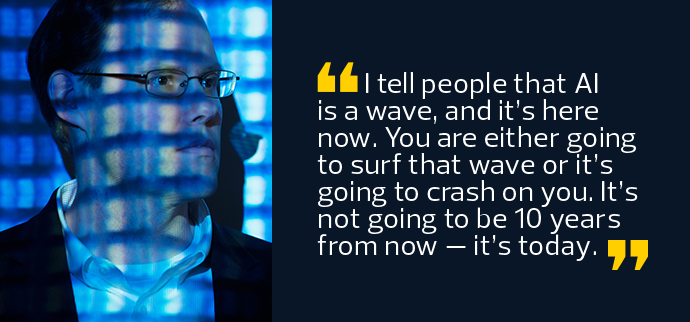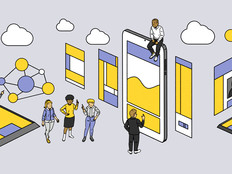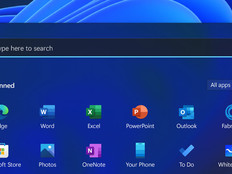Q&A: Artificial Intelligence Expert Shares His Vision of the Future of Education
Joseph Qualls is a clinical assistant professor in the University of Idaho’s College of Engineering. He’s also an expert in artificial intelligence and the founder of a research and development company that uses AI to solve problems for the U.S. military and industry. In Qualls’s vision of the future, AI will dramatically change the way we deliver healthcare, entertain ourselves, conduct warfare and, of course, teach college students. He recently spoke with EdTech Managing Editor Amy Burroughs about what he sees on the horizon.
SIGN UP: Get more news from the EdTech newsletter in your inbox every two weeks!
EDTECH: How fast is AI technology developing?
QUALLS: AI is going to come far more quickly than even I can predict. Look at personal assistants: A year ago, they were nowhere, and they are everywhere now. So, the changes are coming and they’re coming fast. I tell people that AI is a wave, and it’s here now. You are either going to surf that wave or it’s going to crash on you. It’s not going to be 10 years from now — it’s today.
EDTECH: Do people understand how fast these changes could arrive?
QUALLS: No, and that’s what scares me the most. I fear there will be a digital divide because people just weren’t thinking about AI. Businesses will go out overnight, new businesses will be formed, some people will be left behind just because they are so afraid of the technology. I believe millennials and future generations will adapt. It’s the previous generation I am not so sure about.
EDTECH: Big Data can be overwhelming without a method of analyzing the data to determine what it tells you to do. Is that why AI is so valuable?
QUALLS: That’s what drove the military to embrace AI. They have sensor technologies on drones, but you have 18-year-old kids who can’t read or understand the data coming in. That’s where we can introduce our AI and say, “There is an explosive right there on that road,” or “There is something going on over here.” Now that soldier is equipped with the tools and the right information. He’s not trying to interpret the data, because it takes a guy who’s got 50 years of experience to look at that data and understand it. So we take his knowledge and put that inside of an AI system.

Look at what Facebook is doing with targeted ads. Companies like Amazon are trying to use AI to figure out what kind of shopping experience they can give you. Can we eliminate shopping and give you the product you need at any given time? That’s what Amazon is trying to do with the Dash buttons. Once they have enough data, they can start giving you products you never even thought about. You can’t go anywhere or do anything nowadays without interacting with some form of AI. You may not recognize it as AI, but it’s there.
EDTECH: Is AI a form of thought, or just a series of mathematical algorithms?
QUALLS: I will probably make many AI people mad when I say that it’s just algorithms. Recently, I was asked, “When will we see conscious AI?” That’s when you interact with something and you can’t tell if it’s human or not — like the Turing test. If you want to talk about a life form, it won’t be created by a human. It will be AI systems writing new AI in ways we have never thought about. That’s when you will have a system that’s thinking on its own and forming its own agenda to do whatever it chooses to do. Currently, there is no AI system on the planet that I know of that does that.
There is high-end research trying to create an AI system that can create more AI systems, but it’s still in infancy right now. I give that another five years before you will start to see published results and some interesting things, but will it be usable anytime soon? Probably not, because most corporations have a task they need AI to do. You write a simple system for that task, and it can’t branch out and do anything else. So, yes, AI is still on the algorithm side. But, like I said, everything changes in a yearly cycle right now, so I could be completely wrong come next year.
EDTECH: What AI applications might we see in higher education?
QUALLS: You are going to see a massive change in education from K–12 to the university. The thought of having large universities and large faculties teaching students is probably going to go away — not in the short-term, but in the long-term. You will have a student interact with an AI system that will understand him or her and provide an educational path for that particular student. Once you have a personalized education system, education will become much faster and more enriching. You may have a student who can do calculus in the sixth grade because AI realized he had a mathematical sense. That personalized education is going to change everything.
Think about things the military has started to do. Instead of putting a war fighter on the battlefield, they are using virtual reality helmets to walk around cities to understand the cultural mindset of wherever they are going. You can’t hire enough people to teach a war fighter that, but an AI system can have thousands of those going at one time. Now you’ve got a war fighter who understands the culture and the background of the area he is going into, and that was AI teaching him. That aspect of leveraging AI to teach is the next frontier of education.
EDTECH: What is the role of the educator in this scenario?
QUALLS: For the next 20 years, your professors will be there to step in when the AI is not ready. Eventually, we may go the way of the dinosaur. Our role may change from educating a student to educating an AI. Our role may become research-oriented, while still paying attention to what’s happening to the AIs themselves. You will probably see systems come online and students interacting with them within 10 to 20 years. I have a daughter who is 2 months old, and I think her education is going to be vastly different from anything we sat through. I’m of the view that she will have a far better education.
EDTECH: If personalized education becomes the norm, will we ask why we ever thought students should all learn the same material, in the same way, at the same time?
QUALLS: When we look back, we will probably consider that education out of the Dark Ages. If we could do one-on-one with our students today, we would. But there are far more students than professors, and that’s where AI can come in. I look at some of these lecture halls with 300 students in a class, and I wonder, “Are they actually learning?” But resources are always a problem. I think that’s what’s going to eventually drive AI to enter the education workforce: necessity.
EDTECH: Is there anything human educators can provide that AI cannot?
QUALLS: Currently, yes. AI is still just algorithms. AI doesn’t have intuition. That’s what a human teacher can provide, so even if AI provides the bulk of the education, you will still have a human watching, interacting with these systems, providing the intuition behind that AI. But if you have massive amounts of students in your class, you are back to square one: You can’t provide that one-on-one experience, so the AI is just as good.
EDTECH: Are there any AI applications for public safety, which is a concern for college campuses?
QUALLS: There is research into allowing AI systems to determine intent. For instance, if a large crowd of people is gathering, what is the likelihood the crowd will turn violent? The idea originated in the Iraq war, to help redirect troops from potentially hostile operations. One area involves collecting meta information from other sensors and social media — for example, the crowd may be gathering for a celebration over a sports game. The second area is recognition within crowd dynamics. Large groups of people can cause tight swirls to form, causing people to become agitated, leading to people fighting and spiraling out of control. Can an AI predict and locate hostile swirls before they escalate?
EDTECH: In 2016, a Georgia Institute of Technology professor used an AI personal assistant to respond to routine questions, and students couldn’t tell the difference.
QUALLS: That’s nothing new. How many times have you had a telemarketer call and you questioned whether you were speaking to a human? Most telemarketers nowadays are glorified chatbots, and they are very good. I like it when they call my house. I start asking weird questions — that’s how you break these types of systems — and the computer can’t figure out what to do, so it just hangs up on you. A human operator will tell you off.
You interact more with AI systems or chatbots than you may realize. If you use a support chat online, most of the time an AI system is answering your questions. When you interact with it, your questions are very specific toward that chatbot, and that’s why it’s able to help you pretty easily.
EDTECH: What about AI applications for campus transportation, such as driverless cars or shuttles?
QUALLS: This is an active discussion on most campuses. The question is, would people ride in an autonomous vehicle? The answer seems to be a 50 percent split. The people who say they will not ride in an autonomous car say they must be in control of the vehicle at all times. This is where I point out, have you flown in a plane in the last five years? Most commercial airlines are on autopilot now. There is potential for campus transportation to be autonomous, but the private sector is beating the universities to the punch. Look at what Uber is doing with autonomous cars. In the future, you’ll just walk outside and pull up your phone, and the car is right there to take you where you want to go. That’s what AI will do: It’s going to provide services for us to make our lives better.









